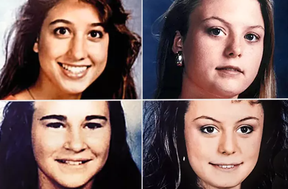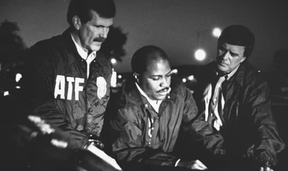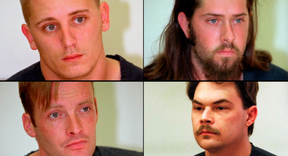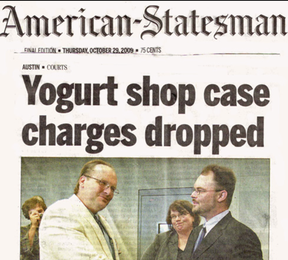The series pulls back the curtain on the families, cops and community who were shaken to their core by the horrific 1991 crime
Article content
Four kids making a couple extra bucks with part-time jobs at a frozen yogurt joint.
Advertisement 2
Article content
Not exactly putting themselves in harm’s way, but that is exactly what they were.
Article content
Article content
On Friday, Dec. 6, 1991, Eliza Thomas, 17, Amy Ayers, 13, and sisters Jennifer Harbison, 17, and Sarah Harbison, 15, were shot to death during a botched heist at I Can’t Believe It’s Yogurt! in Austin, Texas.
After the vile killers shot the girls, they set their bodies ablaze. The killers were never caught, and now HBO is offering a new four-part docuseries, The Yogurt Shop Murders. It premiered on Aug. 3.

The series pulls back the curtain on the families, cops and community who were shaken to their core by the horrific crimes and the agonizing decades since.
It was store manager Reese Price who identified the victims. She volunteered for the macabre duty so the girls’ families wouldn’t have to endure the horrific sight.
“There wasn’t anything there to identify,” Price told series producers. “Fire is very destructive. It’s not forgiving.”
The series shows footage of the shop on the night of the murders as the girls’ date with monsters unfolds in real time. Director Margaret Brown told USA Today that people who have never spoken publicly before talk to producers.
Article content
Advertisement 3
Article content
“These people went through something so specifically awful, but I do think there’s something in that for everyone,” Brown said. “We’re all going to experience pain, and I felt like for me, this was a way to look at this fascinating case, at the same time an exploration of how do people deal with something this hard, (and) what can we learn from that?”
In the wake of the horrendous slayings, a massive media campaign was unleashed in Austin and beyond, desperately appealing for information on the killers. Billboards with chilling photos of the girls dotted the landscape
“A lot of my friends who are crime reporters said this is the most interesting crime that exists,” Brown told the newspaper. “There’s not one with more rabbit holes. This is the mother ship of interesting crime.”
Advertisement 4
Article content

Locals and true crime buffs are obsessed with the vexing case that has been passed from detective to detective as investigators retired over the three-decade course of the investigation.
The latest investigator is Det. Dan Jackson, who took stewardship of the thick, cold case file in 2022. It was the first case he was assigned on his first day with the cold case unit.
“It’s such a huge case,” Jackson said. “I sort of knew at that point I would be with it forever.”
The detective offers several theories as to why the case was never closed. For starters, the blaze that engulfed the shop and bodies wiped out crucial evidence, either incinerated or soaked with water from fire hoses.

Cops believed they had their two killers, and the pair were convicted. Robert Springsteen received a death sentence in 2001 for killing Ayers, and Michael Scott was caged for life for the death of Ayers the following year. And then, their convictions were overturned.
Advertisement 5
Article content
The case went cold again.
Jackson remains confident he will clear the case. The two men initially convicted of the murders refused to take part in the docuseries. It wasn’t always that way. Springsteen participated in another project in 2009.
He told a sales clerk helping him find clothes for his appearance: “I’m sure you probably think it’s really funny, but we’re doing a documentary because I just got off death row.”

Callous attitude aside, a DNA sample that detectives lifted from the crime scene does not belong to either Scott or Springsteen. But with genetic science making quantum leaps, it is not unreasonable for the killers to be identified.
“One of the things that we want the public to know is that this case is active,” Jackson said. “It’s constantly worked on.”
Advertisement 6
Article content
Jackson agrees that forensic technology is likely to play a role in bringing the girls’ murderers to justice.
“If I didn’t think I could solve it, then why get up every day?” he said. “I think that with new technology, new information that we have − that I can’t go into − even since I’ve taken the case over, the ability to do more with less when it comes to forensics is light-years ahead than it was a few years ago.”
“When I started, we needed a certain amount (of DNA),” Jackson explained. “We weren’t even close to it, but that amount that you need is so much less now.”
“I am confident that I will solve this,” he said.
Read More
Advertisement 7
Article content
Jackson added that human intelligence will also play a role in clearing the case, and he hopes the docuseries will trigger memories and witnesses who may have previously been afraid to talk to police.
“Somebody out there knows something,” Jackson said. “That’s one of the things with cold cases. You do get people over time that, for whatever reason, may not have been willing to come forward years ago that now feel more comfortable. Or they thought it was something small and didn’t ever say anything, and they’re like, ‘Well, maybe I should call in this time and mention it.’”
“Who knows? It could be the break we need,” he said.
If you have any information about the case, visit austincrimestoppers.org or send an email to yogurtshop@austintexas.gov.
Article content
Source link
[ad_3]
[ad_4]




